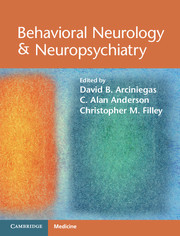Book contents
- Behavioral Neurology & Neuropsychiatry
- Behavioral Neurology & Neuropsychiatry
- Copyright page
- Contents
- Contributors
- Foreword
- Preface
- 1 Introduction
- Section I Structural and Functional Neuroanatomy
- 2 Behavioralneuroanatomy
- 3 Cerebellum
- 4 Whitematter
- 5 Frontal-subcorticalcircuits
- 6 Arousal
- 7 Sleep
- 8 Attention
- 9 Motivation
- 10 Perceptionand recognition
- 11 Memory
- 12 Language
- 13 Affective prosody
- 14 Praxis
- 15 Visuospatialfunction
- 16 Executivefunction
- 17 Comportment
- 18 Emotion
- 19 Personality
- Section II Neurobehavioral and Neuropsychiatric Assessment
- Section III Treatments in Behavioral Neurology & Neuropsychiatry
- Index
4 - Whitematter
from Section I - Structural and Functional Neuroanatomy
Published online by Cambridge University Press: 05 February 2013
- Behavioral Neurology & Neuropsychiatry
- Behavioral Neurology & Neuropsychiatry
- Copyright page
- Contents
- Contributors
- Foreword
- Preface
- 1 Introduction
- Section I Structural and Functional Neuroanatomy
- 2 Behavioralneuroanatomy
- 3 Cerebellum
- 4 Whitematter
- 5 Frontal-subcorticalcircuits
- 6 Arousal
- 7 Sleep
- 8 Attention
- 9 Motivation
- 10 Perceptionand recognition
- 11 Memory
- 12 Language
- 13 Affective prosody
- 14 Praxis
- 15 Visuospatialfunction
- 16 Executivefunction
- 17 Comportment
- 18 Emotion
- 19 Personality
- Section II Neurobehavioral and Neuropsychiatric Assessment
- Section III Treatments in Behavioral Neurology & Neuropsychiatry
- Index
Summary
- Type
- Chapter
- Information
- Behavioral Neurology & Neuropsychiatry , pp. 47 - 58Publisher: Cambridge University PressPrint publication year: 2013



